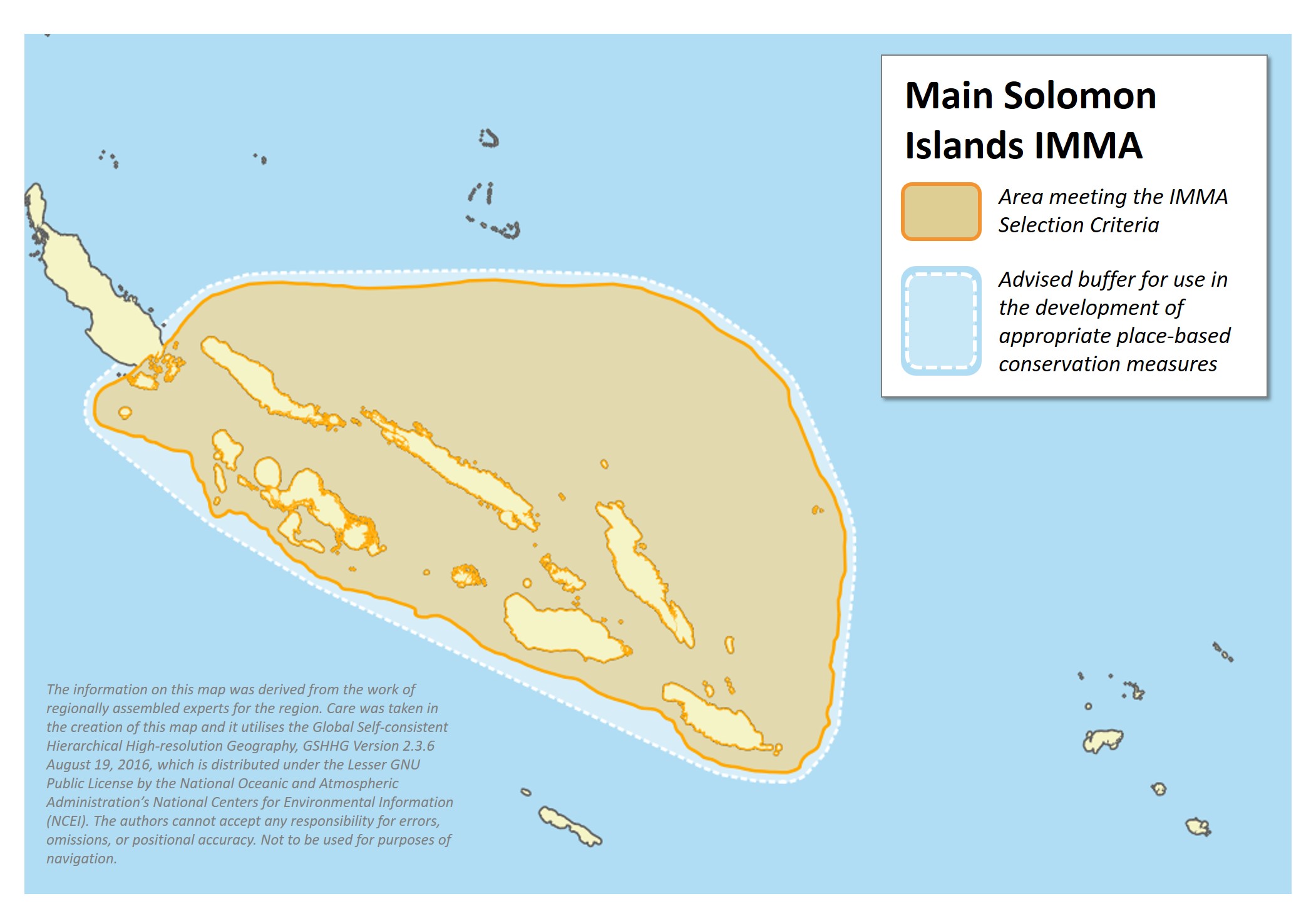Main Solomon Islands IMMA
Area Size
278 494 km2
Qualifying Species and Criteria
Indo-Pacific bottlenose dolphin – Tursiops aduncus
Criterion B (1)
Dugong – Dugong dugon
Criterion A
Omura’s whale – Balaenoptera omurai
Criterion B (2)
Marine Mammal Diversity
Criterion D (2)
Physeter macrocephalus, Peponocephala electra, Mesoplodon densirostris, Lagenodelphis hosei, Kogia breviceps, Ziphius cavirostris, Globicephala macrorhynchus, Pseudorca crassidens, Balaenoptera acutorostrata, Orcinus orca, Stenella attenuata, Steno bredanensis, Tursiops truncatus, Stenella coeruleoalba, Grampus griseus, Delphinus delphis, Orcaella brevirostris, Stenella longirostris
Download fact sheet
Summary
The Main Solomon Islands IMMA includes coastal and offshore waters located in the north-west part of the Solomon Islands, around the islands of Guadalcanal, Malaita, Santa Isabel and New Georgia. Overall, knowledge on marine mammal populations in the area remains scarce but a few dedicated surveys have highlighted a high diversity of species (21) and this is an area of aggregation for Omura’s whales. Photo-identification and genetic data support the presence of small, resident, populations of coastal dolphins, that are genetically distinct from neighbouring populations (spinner dolphins and Indo-pacific bottlenose dolphins). Finally, dugongs (Vulnerable on the IUCN Red List) are widely distributed in the IMMA.
Description of Qualifying Criteria
Criterion A – Species or Population Vulnerability
A study by Bass (2010), based on interviews, showed that dugongs occur throughout the Solomon Islands. Dugong are classified as Vulnerable on the IUCN Red List. Dugong status in the Solomon Islands is poorly known, however a recent questionnaire survey suggests a high rate of bycatch, with 40% of fishermen declaring the by-catch of one dugong in the last five years (Pilcher et al. 2016). Furthermore, 51% of interviewees claimed to know dugong hunters.
Criterion B: Distribution and Abundance
Sub-criterion B1: Small and Resident Populations
Photo-identification data collected over three consecutive years show strong support for the presence of several small and resident populations in the IMMA. Oremus et al. (2013) conducted small boat surveys (n = 62) in the Solomon Islands in November 2009, November 2010 and July 2011. Total research effort was 5196 km in coastal waters of Guadalcanal, Florida Islands, Santa Isabel and Malaita. Photographs were obtained from 44 groups of T. aduncus and 225 unique individuals were identified. Twenty individuals were re-sighted within the same year while 46 individuals were re-sighted between different years. All re-sightings but one (Florida Islands to Guadalcanal) were found within study sites, indicating a high degree of site fidelity and suggesting a demographic partitioning between the study sites. Therefore, the four islands or group of islands appear to shelter distinct populations, most likely isolated demographically from each other. Abundance was estimated to be approximately 100 in Guadalcanal and in Florida Islands and around 300 individuals in Santa Isabel. Abundance estimates for the west coast of Malaita were considered to be less reliable because of insufficient data, however, population size in this area is probably also in the low 100s.
Sub-criterion B2: Aggregations
Shimada and Pastene (1995) described an area of high density for Bryde’s whales in the north the IMMA from a research trip in the Solomon sea in the 1990s. Eight whales presumed to be Bryde’s were also taken in scientific hunting in the late 1970s (Oshumi 1978). Later, Wada (2003) presented evidence that these presumed Bryde’s whales were in fact a distinct species of Balenoptera which he described as Omura’s whales (Balenoptera omurai). Furthermore, Oremus et al. (2013) observed unidentified baleen whales (Balenoptera sp.) very close to shore at each of their four study sites (Guadalcanal, Santa Isabel, Florida Islands and Malaita), involving feeding behavior on one occasion. Although the Balenoptera species was not conclusively identified, total estimated length (ranging from 6 to 10m), and photographs of the rostrum and back of the animals suggest that they were Omura’s whales.
Criterion D: Special Attributes
Sub-criterion D2: Diversity
So far 21 species of marine mammal species have been documented in the IMMA, indicating an area of rich species diversity (Shimada and Pastene 1995, Kahn 2004, Oremus et al. 2014).
Supporting Information
Bass, D.K. 2010. Status of dugong Dugong dugon and Australian snubfin dolphin Orcaella heinsohni, in the Solomon Islands. Pacific Conservation Biology. 16: 133-143.
Brownell Jr., R.L., Ralls, K., Baumann-Pickering, S., Poole, M.M. 2009. Behavior of melon-headed whales, Peponocephala electra, near oceanic islands. Marine Mammal Science 25, 639–658.
Kahn, B. 2006. Oceanic cetaceans and associated habitats. In: Green A, Lokani P, Atu W, Ramohia P, Thomas P, Almany J (eds) Solomon Islands Marine Assessment: Technical report of survey conducted May 13 to June 17, 2004. TNC Pacific Island Countries, Report No. 1/06
Ohsumi, S. 1978. Provisional report on Bryde’s whales caught under special permit in the Southern Hemisphere. Reports of the International Whaling Commission 28: 281-288.
Oremus, M., Leqata, J., Hurutarau, J., Taei, S., Donoghue, M. and Baker, C.S. 2013. Population status of Indo-Pacific bottlenose dolphins, Tursiops aduncus, in the Solomon Islands and assessment of live-capture sustainability. Report (SC/65a/Forinfo32) to the Scientific Committee of the International Whaling Commission.
Oremus, M., Leqata, J. and Baker, C.S. 2015. Resumption of traditional drive hunting of dolphins in the Solomon Islands in 2013. Royal Society Open Science. DOI: 10.1098/rsos.140524.
Oremus, M., Garrique, C., Tezanos-Pinto, G. and Baker, C.S. 2015. Phylogenetic identification and population differentiation of bottlenose dolphins (Tursiops spp.) in Melanesia, as revealed by mitochondrial DNA. Marine Mammal Science. DOI: 10.1111/mms.12210.
Reeves, R.R., Leatherwood, S., Stone, G.S. and Eldredge, G. 1999. Marine mammals in the area served by the South Pacific Regional Environment Programme (SPREP), p. 48. Apia, Samoa: South Pacific Regional Environment Programme.
Shimada, H. and Pastene, L.A. 1995. Report of a sighting survey off the Solomon Islands with comments on Bryde’s whale distribution. Report of the International Whaling Commission 45:413-418.
Takekawa, D. 1996. The method of dolphin hunting and distribution of teeth and meat: dolphin hunting in the Solomon Islands 2. Senri Ethnol. Stud. 42, 67–80.


